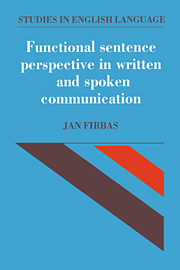Book contents
- Frontmatter
- Contents
- Preface
- List of abbreviations
- Part I Functional sentence perspective in written communication
- 1 Introduction
- 2 The sentence and the carriers of communicative dynamism
- 3 The contextual factor
- 4 The semantic factor
- 5 The theme and the non-theme
- 6 Some special issues of the theory of functional sentence perspective
- 7 Word order and functional sentence perspective
- Part II Functional sentence perspective in spoken communication
- References
- Index
6 - Some special issues of the theory of functional sentence perspective
Published online by Cambridge University Press: 19 November 2009
- Frontmatter
- Contents
- Preface
- List of abbreviations
- Part I Functional sentence perspective in written communication
- 1 Introduction
- 2 The sentence and the carriers of communicative dynamism
- 3 The contextual factor
- 4 The semantic factor
- 5 The theme and the non-theme
- 6 Some special issues of the theory of functional sentence perspective
- 7 Word order and functional sentence perspective
- Part II Functional sentence perspective in spoken communication
- References
- Index
Summary
The first part of the present chapter will amplify the preceding discussions by concentrating on the FSP function of transition proper in connection with (i) the boundary between theme and non-theme both in verbal and in non-verbal distributional fields and the related question of bipartition, tripartition or pluripartition, and (ii) the FSP of questions, negative sentences and commands. The second part will amplify the preceding discussions by returning to (iii) the concept of CD and (iv) the phenomenon of potentiality, and by dealing with (v) the FSP contextual applicability of a semantic and grammatical sentence structure and (vi) the signals of the distribution of CD degrees.
Boundary between theme and non-theme
In verbal fields
In the foregoing, emphasis was laid on the different roles played in communication by the notional component of the verb and its categorial exponents. Let me concentrate on the latter and outline their operation at the syntactic, semantic and FSP levels. Doing so, I shall contribute to the question of the boundary – and link, for that matter – between theme and non-theme.
At the syntactic level, the categorial exponents establish a link between the grammatical subject and the grammatical predicate. In this way, they serve as a centre within the sentence viewed as a field of syntactic relations. (‘Centre’ is not used here as a word order, but as a relational term.)
The syntactic meaning of the categorial exponents is rooted in their semantic content (see, p. 14).
- Type
- Chapter
- Information
- Publisher: Cambridge University PressPrint publication year: 1992



